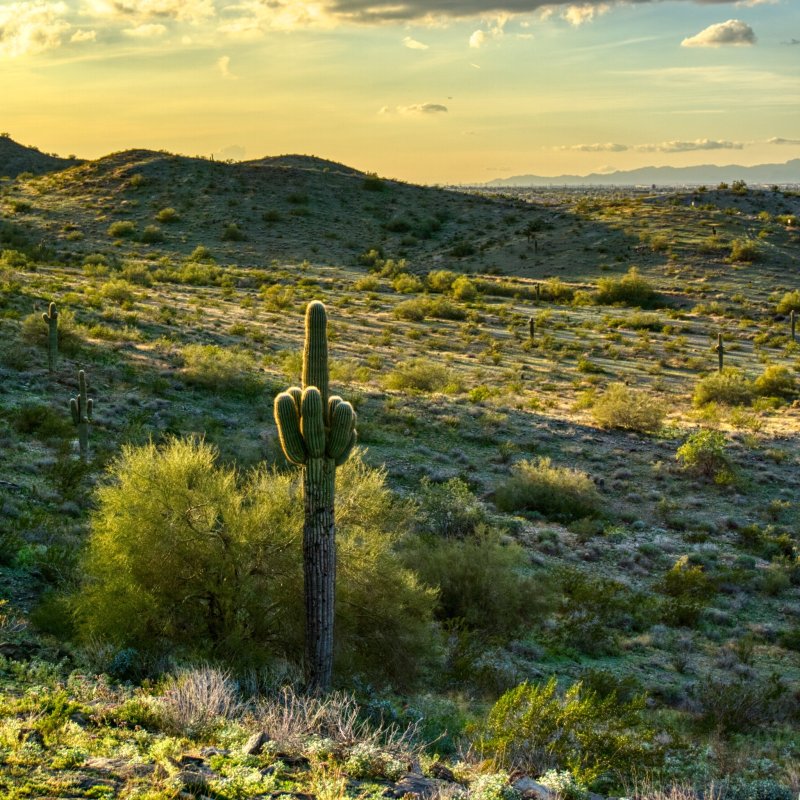
Known as the greenest and hottest desert in the world, the Sonoran Desert stretches from Sonora, Mexico, through Arizona and the southern part of California. It is the only place where the giant saguaro, the symbol of the Southwest and the state flower of Arizona, grows.
Videos by TravelAwaits
The Sonoran Desert is a gorgeous place filled with unique plants and wildlife, plenty of sunshine, and enough water to sustain life. Though it gets extremely hot during the summer, the winter and the shoulder seasons are pleasant. This combination has attracted people for centuries, and today the Sonoran Desert is home to several cities, including one of the largest metropolitan areas in the United States, Phoenix and its vicinity.
The good thing about Phoenix is that it preserves thousands of acres of the desert untouched, even in the middle of the city. This makes it one of the best places to experience this unique environment.
Here’s where to go to get a taste of the beauty of the Sonoran Desert.

1. South Mountain Park And Preserve, Phoenix
The nation’s largest wilderness park within city limits, South Mountain Park and Preserve preserves about 16,000 acres of desert. A scenic road leads to the top, and more than 50 miles of trails crisscross the protected desert.
The visitor center offers an introduction to the plants, animals, and natural history of the Sonoran Desert. After stopping there, take a stroll on the paved and accessible Judith Tunnel Trail for a close-up desert experience. Then drive the 5.5-mile scenic summit road to the top and enjoy the views from the Dobbins Lookout, the highest point you can access in the park.
Besides hiking and biking trails to explore on your own, the park offers guided horseback tours. Throughout the park, you’ll see not only desert vegetation, but also thousands of petroglyphs left behind by the Hohokam, the ancient people who lived here before Phoenix existed.
For an unexpected and different attraction, stop at the Mystery Castle in the foothills of the mountain.
Pro Tip: The scenic summit road is closed to all motorized vehicles on Silent Sunday, the fourth Sunday of each month. On Silent Sunday, you can park near Central Avenue and walk, jog, or bike up the mountain.

2. McDowell Sonoran Preserve, Scottsdale
A large, protected, and sustainable desert habitat in Scottsdale, the McDowell Sonoran Preserve features some of the most stunning desert scenery. The area is accessible via a series of interconnected multiuse trails, with trailheads in a few different locations.
The busiest and largest trailhead is Gateway, offering access to the accessible Bajada Nature Trail and many others. It is also the best introduction to the area. You’ll find water, restrooms, and shaded ramadas here.
You’ll also find accessible nature trails at the Lost Dog Wash Trailhead and the Brown’s Ranch Trailhead. The Tom’s Thumb Trailhead is the least busy and offers access to more strenuous trails, from the vertical Tom’s Thumb to a flatter but rockier one. The Tom’s Thumb Trail has no drinking water, so don’t forget to bring your own.
Besides hiking, you can use the trails in the McDowell Sonoran Preserve for biking, running, or horseback riding.

3. Desert Botanical Garden, Phoenix
If you want to learn more about the plants of the Sonoran Desert, visit the Desert Botanical Garden in Papago Park. Stroll the themed trails to learn about the amazing plants of the Sonoran Desert, including towering cacti, succulents, and colorful desert wildflowers. Enjoy the permanent garden exhibits and temporary art installations along the trails as you discover the desert and the amazing plants that have adapted to this unique environment.
The paved and accessible Sonoran Desert Nature Loop Trail offers great views of the surrounding mountains and an opportunity to explore the surrounding desert. To understand how the people of the desert use these plants for food, shelter, tools, and cultural activities, walk along the Plants & People of the Sonoran Desert Loop Trail. You’ll find gorgeous wildflowers along the Desert Wildflower Loop Trail if you visit in the early spring or late winter. You’ll even have the opportunity to learn about desert plants from all over the world — and compare them to those living in the Sonoran Desert — on the Desert Discovery Loop Trail. The Center for Desert Living Trail showcases ideas and strategies for sustainable living in this seemingly inhospitable environment.

4. Saguaro National Park, Tucson
Though you will see giant saguaros in and around Phoenix, you’ll find the largest concentration of these symbols of the Southwest at Saguaro National Park in Tucson. This unique, slow-growing cactus can grow up to 50 feet tall, survive long periods of drought, and live for more than 200 years. A night bloomer, it boasts gorgeous, large flowers from early May through June that are open in the morning until the early afternoon. By late June, these turn into edible red fruit.
You can learn all about the giant saguaro and other cactus varieties of the Sonoran Desert at one of the two visitor centers of Saguaro National Park. Then take the scenic roads through the park and walk a few of the trails to see them. Besides the giant saguaros — and you’ll see many of different shapes and sizes in the park — you’ll see other cacti, different varieties of chollas, fishhook barrels, and prickly pears among them.
The trees and shrubs provide some shade in the desert. You’ll also encounter plenty of birds, including roadrunners, Gila woodpeckers, and Gambel’s quail. Saguaro National Park is also home to a wide variety of reptiles, desert tortoises, and Gila monsters and a few varieties of rattlesnakes, though they’re rarely seen during the winter and shoulder seasons.

5. Arizona-Sonora Desert Museum, Tucson
You’ll find no better place to experience and learn about the ecosystems, flora, and fauna of the Sonoran Desert than the Arizona-Sonora Desert Museum. A combination botanical garden and zoo, this desert museum is known for its conservation efforts and its educational exhibits on the desert’s unique and varied ecosystems.
You’ll find one of the greatest varieties of both desert plants and wildlife here — and even an aquarium. Unexpected in a desert museum, it highlights the importance of the rivers of the region and the Sea of Cortez in creating the lush ecosystems of the Sonoran Desert.
Walk through the museum’s gardens to see thousands of varieties of plants growing in the area, including cacti, agaves, yuccas, palo verde varieties, and desert grasses. You’ll find a walk-in aviary filled with birds of the desert. The riparian corridor by a stream is home to river otters, beavers, bighorn sheep, coatis, and other wildlife. The cat canyon is one of my favorite spots, with its gray foxes, bobcats, and ocelots. You’ll walk through the desert grassland as well as the mountain woodland, where you’ll get to see a rescued mountain lion among other desert predators.
If you’re visiting during the winter, take the desert loop trail and walk through the untouched natural settings. Before leaving, spend some time in the replica limestone cave.

6. Boyce Thompson Arboretum, Superior
The oldest botanical garden in Arizona, the Boyce Thompson Arboretum, showcases flora and fauna of the surrounding desert, plus much more. Here, you’ll have the opportunity to explore a few different ecosystems of the Sonoran Desert and compare it to other deserts of the world. You’ll find exhibits on the deserts of Australia, South America, Africa, and Asia, giving you a better understanding of the desert environment in general. You’ll also walk through diverse terrain, including cactus gardens; a lakeshore; stark, rocky terrain; and lush shaded areas by Queen Creek.

7. Lost Dutchman State Park, Apache Junction
At the foot of the Superstition Mountains, Lost Dutchman State Park features some of the most beautiful scenery of the Sonoran Desert. Trails lead into the Superstition Wilderness and Tonto National Forest. Take a short stroll along the paved and accessible Native Plant Trail to familiarize yourself with the plants of the Sonoran Desert, or hike the slightly more challenging trails, like the Treasure Loop Trail. If you are really looking for a challenge, hike the Siphon Draw Trail into the Superstitions.
You can bike or camp here, too, and spending more time will give you the opportunity to see wildlife in the area. Mule deer, coyotes, roadrunners, and javelinas are common. If you visit in the early spring, depending on the year, you’ll find the desert full of color, as bright wildflowers blanket some areas.
What To Know Before You Go
No matter where you go to experience the Sonoran Desert, you will be treated to some of the most unique scenery you can imagine. Though you might find it greener than you expected, it is still dry, and even in the middle of the winter, you might get dehydrated. Make sure you carry plenty of water, no matter when you go. Don’t forget your sunscreen and hat, since the sun is always strong.
The best time to experience the Sonoran Desert is in the winter, when temperatures are in the 70s and the skies are blue. But the desert is the most beautiful in the early spring, when the wildflowers bloom and everything is green. No matter what time you visit, you’ll find the desert to be greener and more vibrant right after rain.
Summer is the time to avoid the Sonoran Desert, since temperatures are constantly in the 100s, the sun is harsh, and the vegetation appears dead.
No matter when you visit, you’ll enjoy the experience. The Sonoran Desert may seem harsh and inhospitable, but it is home to an amazingly diverse and fragile ecosystem you’ll learn to appreciate.
